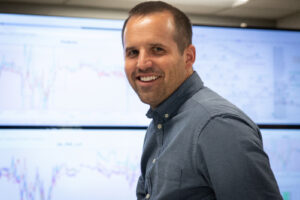 Since the advent of solar and wind power stations, traditional coal power plants haven’t had to operate at a hundred percent capacity all of the time to feed electricity to a city. As wind and solar power generation begins to pick up during the day, coal plants can ramp down to balance it out, and that makes for cleaner air.
Since the advent of solar and wind power stations, traditional coal power plants haven’t had to operate at a hundred percent capacity all of the time to feed electricity to a city. As wind and solar power generation begins to pick up during the day, coal plants can ramp down to balance it out, and that makes for cleaner air.
But a team of University of Utah chemical engineers are working to make that system of energy management even better. The team, led by U chemical engineering assistant professor Kody Powell, has received a $3.8 million grant from the U.S. Department of Energy to further develop software that manages the operation of coal power plants so they can ramp up and down more efficiently as wind and solar power generation goes up and down depending on the weather.
The software, called Griffin Open Systems, is used in coal power plants to regulate their operations. Since power plants can only produce the amount of electricity equal to a community’s current demand and not more, the software tells the coal plant to lower its production of electricity as the solar and wind power stations ramp up. Conversely, if there is heavy cloud cover or no wind, causing the wind and solar power generation to drop, the software can tell the coal plant to increase its production.
“The efficiency will improve. That means the same amount of power with less coal. That also means you’re producing less carbon dioxide for the same amount of power,” says Powell. “Our goal is to use 5% less fuel which would result in 5% less carbon dioxide in the atmosphere.”
In 2018, 27.4% of the nation’s electricity was generated by coal plants, according to the U.S. Energy Information Administration, while 8.2% comes from wind and solar. States such as California, Hawaii and South Dakota produce somewhat comparable amounts of electricity each through coal and wind every year.
Powell said the group will be developing better software algorithms that determine how much fuel and air to inject into the boilers of the coal plants for better efficiency and lower emissions of particulate matter into the atmosphere.
“We’re changing the software so the plant will look into the future to predict the conditions and try to make a plan of how the plant goes from one point of operation to a new point of operation,” he says.
He also adds that this software and its new artificial intelligence models could be used with other types of power plants such as ones that run on natural gas or biofuels.
Other engineers involved in the research include U chemical engineering Distinguished Professor David Pershing, chemical engineering adjunct professor Klas Andersson and Brigham Young University chemical engineering associate professor Andrew Fry.